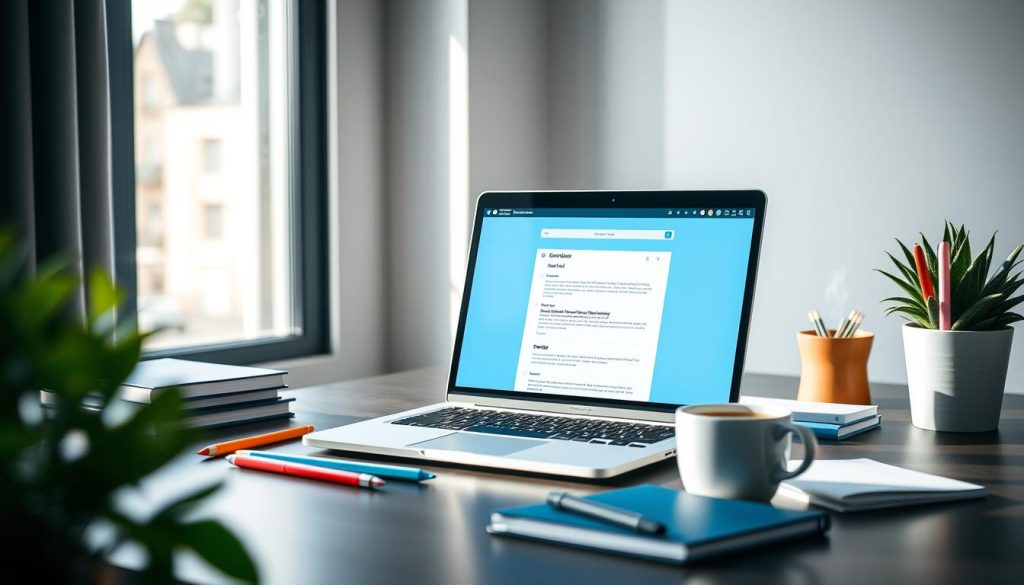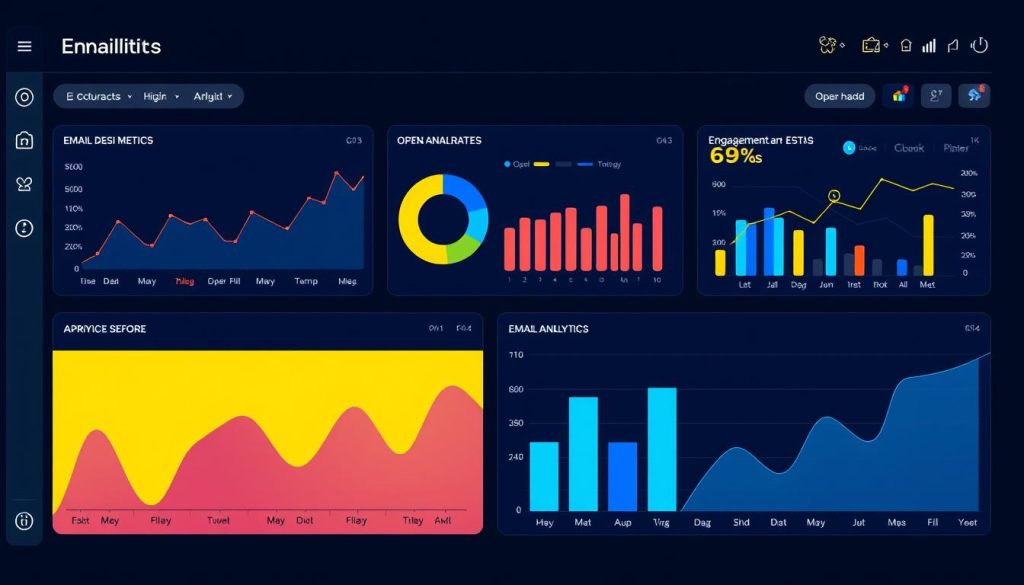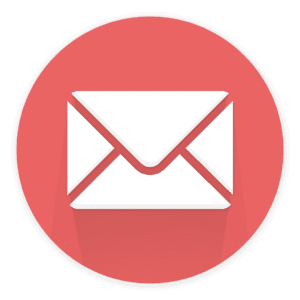In today’s market, business brokers need new ways to get ahead. Cold emails are a key tool for reaching more people. When done right, they can really help your business grow.
This article will show you how to make the most of cold email outreach. We’ll cover the basics, how to write great emails, and using data to improve your campaigns. You’ll learn what makes a cold email campaign successful.
Whether you’re starting with cold emails or want to improve, this guide has you covered. It will give you the skills to get more leads and close more deals with email outreach.
Key Takeaways
- Cold emails are a valuable lead generation tool for business brokers
- Personalization and compelling subject lines are crucial for high open rates
- Building a targeted email list is essential for reaching the right audience
- Engaging email content should be concise, credible, and include strong calls to action
- Data analysis and A/B testing help optimize cold email campaigns for better results
Understanding Cold Emails and Their Importance
In the world of business brokerage, connecting with potential clients is key to success. Cold emails are a great way to reach out to prospects. They help brokers expand their network, get more leads, and secure listings.
What Are Cold Emails?
Cold emails are messages sent to people you’ve never met before. They aim to introduce your services and start a business relationship. Unlike spam, cold emails are personalized and offer value.
Why Cold Emails Matter for Brokers
Cold emails are a powerful tool for lead generation for business brokers. By sending out compelling messages to the right people, brokers can:
- Reach more potential clients
- Build awareness of their services
- Show their expertise and credibility
- Nurture relationships with prospects
Cold emails help brokers find new opportunities instead of just waiting for referrals or inquiries.
Benefits of Cold Email Outreach
Starting a cold email outreach campaign has many benefits for business brokers:
| Benefit | Description |
|---|---|
| Cost-effective | Cold emails are cheap to send to many people without big ad costs. |
| Scalable | Brokers can send personalized emails to lots of people quickly with automated tools. |
| Measurable | Email marketing tools show how well emails are doing, like open rates and clicks. |
| Targeted | Brokers can send emails that really matter to each person by segmenting their list. |
“Cold email outreach has been a game-changer for our brokerage. It has allowed us to connect with business owners who may not have otherwise known about our services.” – Sarah Johnson, Business Broker
Understanding cold emails and using their benefits can help business brokers grow their client base. It’s a key step in their lead generation efforts.
Crafting the Perfect Cold Email
To make effective cold emails that get leads and engagement, knowing what makes an email stand out is key. Focus on personalization, great subject lines, and value for your recipients. This way, you boost your cold email success.
Key Components of an Effective Cold Email
An effective cold email needs a few key things:
- A personalized greeting with the recipient’s name
- A clear reason for reaching out
- A strong value proposition showing the benefits of working with you
- A call-to-action to get the recipient to act
With these elements, your cold emails will connect with your audience and help your business grow.
Personalization: Make It Real
Personalization is a powerful tool for cold emails. By researching and tailoring your messages, you create a real connection. This makes your emails stand out from generic ones.
Personalized emails improve click-through rates by an average of 14% and conversions by 10%.
To personalize your cold emails, try these tactics:
- Use the recipient’s name in the greeting and email
- Mention their company, industry, or recent achievements
- Show how your offering solves their specific challenges
Compelling Subject Lines
Your email’s subject line is your first impression. It must grab attention and make them want to open it. A good subject line is short, relevant, and intriguing. Avoid spam words to avoid the junk folder.
| Effective Subject Lines | Poor Subject Lines |
|---|---|
| Quick question about [company name] | URGENT: Open now for amazing offer! |
| Idea for improving [specific challenge] | FW: partnership opportunity |
| [Name], let’s discuss your [industry] goals | Re: touching base |
By focusing on personalization, crafting great subject lines, and offering value, you’ll create effective cold emails. These will help your business brokerage generate leads.
Building a Targeted Email List
To make your cold email campaigns better, focus on building a targeted email list. Identify your ideal clients and organize their contact info. This way, you boost your chances of making real connections and closing deals.
Identifying Your Ideal Client
Start by defining your ideal client. Think about their industry, company size, location, and what problems you can solve. Knowing your audience well helps you craft better messages and connect more effectively.
Tools for List Building
There are many tools to help you build your email list. Some top choices include:
- LinkedIn Sales Navigator
- ZoomInfo
- Hunter.io
- Clearbit
These tools help you find and add potential clients to your list. They make it easier to build a targeted list of prospects.
Organizing Contact Information
After gathering your list, organize the contact info well. A good contact management system helps you track your outreach. It keeps your cold email campaigns organized and effective.
| Contact Management Tool | Key Features |
|---|---|
| HubSpot CRM | Contact tracking, email integration, deal management |
| Salesforce | Customizable fields, automation, analytics |
| Pipedrive | Visual pipeline, email sync, mobile app |
Using these tools, you can make your outreach smoother. You can track interactions and keep your list organized and up-to-date.
Writing Engaging Email Content
Making your emails stand out is key to grabbing your audience’s attention. This can lead to more people opening and clicking on your emails. Here are some tips for writing cold emails that grab attention:
Keeping Your Message Concise
In today’s world, emails are everywhere. To get noticed, keep your messages short and to the point. Use short sentences that get your message across quickly. Your goal is to engage and prompt action, not flood them with info.

Establishing Credibility
When you send cold emails, showing you’re credible is important. Use social proof like client testimonials or awards to build trust. Also, show your industry expertise to gain credibility.
“Credibility is the foundation of trust, and trust is the currency of business.”
– Brian Tracy
Utilizing Strong Calls to Action
A good call to action (CTA) is crucial. It should be clear and compelling, guiding recipients to act. Use action words and create a sense of urgency. Your goal is to start a conversation and build a relationship.
| CTA Type | Example |
|---|---|
| Schedule a Consultation | “Book a free 15-minute discovery call today!” |
| Download a Resource | “Get your free guide to successful business brokering now!” |
| Reply to Email | “I’d love to hear your thoughts on this. Reply and let me know!” |
By focusing on concise messages, credibility, and strong CTAs, you can craft engaging email content. This will resonate with your audience and prompt them to act.
Timing and Frequency of Cold Emails
Timing and frequency are key in cold email outreach. Getting it right can boost your open and response rates. It also helps in building strong relationships with potential clients.
Best Times to Send Cold Emails
Studies show Tuesdays, Wednesdays, and Thursdays are the best days for cold emails. These days tend to have higher open and response rates. The best times are between 10 AM and 11 AM, or 1 PM and 2 PM, when people are most active.
Here’s a quick overview of the best times to send cold emails:
| Day | Best Time |
|---|---|
| Tuesday | 10 AM – 11 AM, 1 PM – 2 PM |
| Wednesday | 10 AM – 11 AM, 1 PM – 2 PM |
| Thursday | 10 AM – 11 AM, 1 PM – 2 PM |
How Often Should You Follow Up?
Following up on your initial cold email is key to getting a response. But, be careful not to be too pushy. Aim for a follow-up every 3-5 days, with a maximum of 3-4 emails.
Keep your follow-up emails short, friendly, and focused on the value you offer. Personalize each email to show you’ve done your homework and care about helping the recipient.
The fortune is in the follow-up.
By optimizing your email timing and follow-up strategy, you can greatly improve your cold email success. This helps in building stronger relationships with potential clients.
Leveraging Data and Analytics
In the world of email marketing, using analytics is key. It helps you improve your cold email campaigns. By tracking open and response rates, you learn what works and what doesn’t.
Tracking Open and Response Rates
It’s important to watch open and response rates. Open rates show who opened your email. Response rates show who replied or took action.
Many tools can track these metrics for you. Some top ones are:
- Mailchimp
- Constant Contact
- HubSpot
- Google Analytics

Using these tools lets you see how your campaigns are doing. You can then make better choices for your strategy.
Analyzing What Works and What Doesn’t
After tracking your rates, it’s time to see what’s effective. Look for patterns in your data to find what your audience likes.
Consider things like:
| Factor | Impact on Open Rates | Impact on Response Rates |
|---|---|---|
| Subject line | High | Low |
| Personalization | Medium | High |
| Call-to-action | Low | High |
| Timing | Medium | Medium |
By looking at these factors, you can see what boosts engagement and conversions. Use this knowledge to tweak your emails and approach for better results.
Data is the new oil. It’s valuable, but if unrefined it cannot really be used.
Remember, email marketing is a continuous process. Keep an eye on your metrics, try new things, and adjust based on your data. By using data to guide your actions, you can improve your cold email campaigns and help your business grow.
A/B Testing Your Cold Email Campaigns
A/B testing is a key method for improving email campaigns. It helps business brokers test different subject lines, email content, and calls to action. This way, they can make better decisions and get better results.
How to Set Up A/B Tests
Setting up A/B tests is easy:
- Choose what you want to test, like subject lines or calls to action.
- Make different versions of your chosen element, keeping others the same.
- Split your email list into equal parts for fair comparison.
- Send each version to its group and watch how they perform.
When testing, focus on one thing at a time. This helps you see how each change affects your campaign. It lets you make smart choices based on solid data.
Interpreting the Results
After your test, it’s time to look at the results. Consider these key metrics:
| Metric | Description |
|---|---|
| Open rate | The percentage of recipients who opened your email |
| Click-through rate (CTR) | The percentage of recipients who clicked on a link in your email |
| Conversion rate | The percentage of recipients who took the action you wanted, like scheduling a call |
By comparing these metrics, you can see what works best. Use this info to make your future campaigns even better.
A/B testing is not a one-time event, but an ongoing process of learning, adapting, and improving.
Use A/B testing to make your cold email campaigns better. It’s a powerful tool for driving success in your business brokerage.
Common Mistakes to Avoid
When you’re a business broker, it’s key to avoid common mistakes in cold emails. These errors can block your success. Knowing and avoiding these mistakes can help you reach your audience and make meaningful connections.
Overcoming Spam Filters
One big mistake is setting off spam filters. This stops your email from reaching your prospect. To avoid this, don’t use words like “free,” “guarantee,” or “act now.” Also, keep your email list updated and only send to those who have agreed to receive emails.
Avoiding Generic Messaging
Generic emails are another big mistake. Sending the same message to everyone is ignored or deleted. Instead, personalize each email. Show you’ve done your homework on the recipient and their business. Tailor your message to their needs and challenges to grab their attention and build trust.
Misunderstanding Your Audience
Not knowing your audience can make your emails ineffective. Before sending, think about your ideal client’s goals, challenges, and motivations. By seeing things from their perspective, you can write a message that resonates and encourages action.
“The key to successful cold emailing is to avoid common mistakes and focus on delivering value to your target audience.”
To wrap up, here are the top three mistakes to avoid in your cold email strategy:
- Triggering spam filters with inappropriate content or poor sender reputation
- Using generic, impersonal messaging that fails to capture attention
- Misunderstanding your target audience’s needs, goals, and pain points
| Mistake | Solution |
|---|---|
| Spam Filters | Avoid trigger words and maintain good sender reputation |
| Generic Messaging | Personalize each email based on research and tailoring |
| Audience Misunderstanding | Consider your ideal client’s perspective and needs |
By avoiding these common mistakes and focusing on delivering value, you can improve your cold email strategy. This will help you succeed as a business broker.
Scaling Your Cold Email Strategy
As your business brokerage grows, scaling your cold email strategy is key. Using email automation tools can save you time and resources. These tools help personalize emails, track performance, and improve results.
When picking an email automation platform, look at ease of use and integration with your systems. Also, make sure it can segment your email list. Automation helps send emails to the right people at the right time, boosting lead generation and deal closure.
Staying Compliant with Email Regulations
Scaling your cold email strategy means following email regulations like the CAN-SPAM Act. These rules protect consumers from unwanted emails. Not following them can lead to fines and harm your reputation. Always include an opt-out option, your physical address, and avoid misleading subject lines.
Following best practices and staying current with email laws keeps your reputation positive and avoids legal trouble. Regularly check your email campaigns to ensure they comply with the law and effectively reach your audience.






